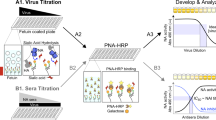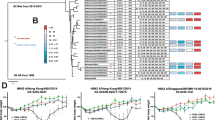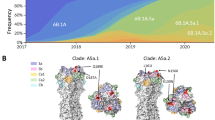Abstract
A(H3N2) virus predominated recent influenza seasons, which has resulted in the rigorous investigation of haemagglutinin, but whether neuraminidase (NA) has undergone antigenic change and contributed to the predominance of A(H3N2) virus is unknown. Here, we show that the NA of the circulating A(H3N2) viruses has experienced significant antigenic drift since 2016 compared with the A/Hong Kong/4801/2014 vaccine strain. This antigenic drift was mainly caused by amino acid mutations at NA residues 245, 247 (S245N/S247T; introducing an N-linked glycosylation site at residue 245) and 468. As a result, the binding of the NA of A(H3N2) virus by some human monoclonal antibodies, including those that have broad reactivity to the NA of the 1957 A(H2N2) and 1968 A(H3N2) reference pandemic viruses as well as contemporary A(H3N2) strains, was reduced or abolished. This antigenic drift also reduced NA-antibody-based protection against in vivo virus challenge. X-ray crystallography showed that the glycosylation site at residue 245 is within a conserved epitope that overlaps the NA active site, explaining why it impacts antibody binding. Our findings suggest that NA antigenic drift impacts protection against influenza virus infection, thus highlighting the importance of including NA antigenicity for consideration in the optimization of influenza vaccines.
This is a preview of subscription content, access via your institution
Access options
Access Nature and 54 other Nature Portfolio journals
Get Nature+, our best-value online-access subscription
$29.99 / 30 days
cancel any time
Subscribe to this journal
Receive 12 digital issues and online access to articles
$119.00 per year
only $9.92 per issue
Buy this article
- Purchase on Springer Link
- Instant access to full article PDF
Prices may be subject to local taxes which are calculated during checkout






Similar content being viewed by others
Data availability
The data that support the findings of this study are available from the corresponding author on request. The atomic coordinates and structure factors for the B10 Fab–MN/10 NA complex have been deposited to the PDB (www.pdb.org) under the accession code 6N6B.
References
Kissling, E., Rondy, M. & I-MOVE/I-MOVE+ study team. Early 2016/17 vaccine effectiveness estimates against influenza A(H3N2): I-MOVE multicentre case control studies at primary care and hospital levels in Europe. Euro Surveill. 22, 30464 (2017).
Sullivan, S. G. et al. Low interim influenza vaccine effectiveness, Australia, 1 May to 24 September 2017. Euro Surveill. 22, 17-00707 (2017).
Paules, C. I., Sullivan, S. G., Subbarao, K. & Fauci, A. S. Chasing seasonal influenza—the need for a universal influenza vaccine. New Engl. J. Med. 378, 7–9 (2018).
Appiah, G. D. et al. Influenza activity—United States, 2014-15 season and composition of the 2015-16 influenza vaccine. MMWR Morb. Mortal. Wkly Rep. 64, 583-590 (2015).
Flannery, B. et al. Interim estimates of 2017-18 seasonal influenza vaccine effectiveness—United States, February 2018. MMWR Morb. Mortal. Wkly Rep. 67, 180–185 (2018).
Zimmerman, R. K. et al. 2014-2015 influenza vaccine effectiveness in the United States by vaccine type. Clin. Infect. Dis. 63, 1564–1573 (2016).
Skowronski, D. M. et al. Early season co-circulation of influenza A(H3N2) and B(Yamagata): interim estimates of 2017/18 vaccine effectiveness, Canada, January 2018. Euro Surveill. 23, 18-00035 (2018).
D’Mello, T. et al. Update: influenza activity—United States, September 28, 2014-February 21, 2015. MMWR Morb. Mortal. Wkly Rep. 64, 206–212 (2015).
Chambers, B. S., Parkhouse, K., Ross, T. M., Alby, K. & Hensley, S. E. Identification of hemagglutinin residues responsible for H3N2 antigenic drift during the 2014-2015 influenza season. Cell Rep. 12, 1–6 (2015).
Zost, S. J. et al. Contemporary H3N2 influenza viruses have a glycosylation site that alters binding of antibodies elicited by egg-adapted vaccine strains. Proc. Natl Acad. Sci. USA 114, 12578–12583 (2017).
Wu, N. C. et al. A structural explanation for the low effectiveness of the seasonal influenza H3N2 vaccine. PLoS Pathog. 13, e1006682 (2017).
Murphy, B. R., Kasel, J. A. & Chanock, R. M. Association of serum anti-neuraminidase antibody with resistance to influenza in man. New Engl. J. Med. 286, 1329–1332 (1972).
Monto, A. S. et al. Antibody to influenza virus neuraminidase: an independent correlate of protection. J. Infect. Dis. 212, 1191–1199 (2015).
Monto, A. S. & Kendal, A. P. Effect of neuraminidase antibody on Hong Kong influenza. Lancet 1, 623–625 (1973).
Treanor, J. Influenza vaccine—outmaneuvering antigenic shift and drift. New Engl. J. Med. 350, 218–220 (2004).
De Jong, J. C., Rimmelzwaan, G. F., Fouchier, R. A. & Osterhaus, A. D. Influenza virus: a master of metamorphosis. J. Infect. 40, 218–228 (2000).
Gao, J., Couzens, L. & Eichelberger, M. C. Measuring influenza neuraminidase inhibition antibody titers by enzyme-linked lectin assay. J. Vis. Exp. 115, e54573 (2016).
Wan, H. et al. Comparison of the efficacy of N9 neuraminidase-specific monoclonal antibodies against influenza A(H7N9) virus infection. J. Virol. 92, e01588-17 (2018).
Eichelberger, M. C., Hassantoufighi, A., Wu, M. & Li, M. Neuraminidase activity provides a practical read-out for a high throughput influenza antiviral screening assay. Virol. J. 5, 109 (2008).
Venkatramani, L. et al. An epidemiologically significant epitope of a 1998 human influenza virus neuraminidase forms a highly hydrated interface in the NA-antibody complex. J. Mol. Biol. 356, 651–663 (2006).
Wan, H. et al. Molecular basis for broad neuraminidase immunity: conserved epitopes in seasonal and pandemic H1N1 as well as H5N1 influenza viruses. J. Virol. 87, 9290–9300 (2013).
Chen, Y. Q. et al. Influenza Infection in humans induces broadly cross-reactive and protective neuraminidase-reactive antibodies. Cell 173, 417–429 (2018).
Wan, H. et al. Structural characterization of a protective epitope spanning A(H1N1)pdm09 influenza virus neuraminidase monomers. Nat. Commun. 6, 6114 (2015).
Lee, J. T. & Air, G. M. Contacts between influenza virus N9 neuraminidase and monoclonal antibody NC10. Virology 300, 255–268 (2002).
Colman, P. M. et al. Three-dimensional structure of a complex of antibody with influenza virus neuraminidase. Nature 326, 358–363 (1987).
Krissinel, E. & Henrick, K. Inference of macromolecular assemblies from crystalline state. J. Mol. Biol. 372, 774–797 (2007).
Jagadesh, A., Salam, A. A., Mudgal, P. P. & Arunkumar, G. Influenza virus neuraminidase (NA): a target for antivirals and vaccines. Arch. Virol. 161, 2087–2094 (2016).
Cate, T. R. et al. A high dosage influenza vaccine induced significantly more neuraminidase antibody than standard vaccine among elderly subjects. Vaccine 28, 2076–2079 (2010).
Hassantoufighi, A. et al. A practical influenza neutralization assay to simultaneously quantify hemagglutinin and neuraminidase-inhibiting antibody responses. Vaccine 28, 790–797 (2010).
Eichelberger, M. C., Morens, D. M. & Taubenberger, J. K. Neuraminidase as an influenza vaccine antigen: a low hanging fruit, ready for picking to improve vaccine effectiveness. Curr. Opin. Immunol. 53, 38–44 (2018).
Couch, R. B. et al. Randomized comparative study of the serum antihemagglutinin and antineuraminidase antibody responses to six licensed trivalent influenza vaccines. Vaccine 31, 190–195 (2012).
Memoli, M. J. et al. Evaluation of antihemagglutinin and antineuraminidase antibodies as correlates of protection in an influenza A/H1N1 virus healthy human challenge model. mBio 7, e00417-16 (2016).
Flannery, B. et al. Interim estimates of 2016-17 seasonal influenza vaccine effectiveness—United States, February 2017. MMWR Morb. Mortal. Wkly Rep. 66, 167–171 (2017).
Neumann, G. et al. Generation of influenza A viruses entirely from cloned cDNAs. Proc. Natl Acad. Sci. USA 96, 9345–9350 (1999).
Edgar, R. C. MUSCLE: a multiple sequence alignment method with reduced time and space complexity. BMC Bioinform. 5, 113 (2004).
Yang, S. et al. Integrated glycoprotein immobilization method for glycopeptide and glycan analysis of cardiac hypertrophy. Anal. Chem. 87, 9671–9678 (2015).
An, Y. et al. Comparative glycomics analysis of influenza hemagglutinin (H5N1) produced in vaccine relevant cell platforms. J. Proteome Res. 12, 3707–3720 (2013).
Yang, S., Wu, W. W., Shen, R. F., Bern, M. & Cipollo, J. Identification of sialic acid linkages on intact glycopeptides via differential chemical modification using intactGIG-HILIC. J. Am. Soc. Mass Spectrom. 29, 1273–1283 (2018).
Blom, N., Sicheritz-Ponten, T., Gupta, R., Gammeltoft, S. & Brunak, S. Prediction of post-translational glycosylation and phosphorylation of proteins from the amino acid sequence. Proteomics 4, 1633–1649 (2004).
Paz-Parente, J. et al. Primary structure of a novel N-glycosidic carbohydrate unit, derived from hen ovomucoid. A 500-MHz 1H-NMR study. FEBS Lett. 152, 145–152 (1983).
Parente, J. P. et al. A novel type of carbohydrate structure present in hen ovomucoid. J. Biol. Chem. 257, 13173–13176 (1982).
Barnett, J. L., Yang, J., Cai, Z., Zhang, T. & Wan, X. F. AntigenMap 3D: an online antigenic cartography resource. Bioinformatics 28, 1292–1293 (2012).
Cai, Z., Zhang, T. & Wan, X. F. A computational framework for influenza antigenic cartography. PLoS Comput. Biol. 6, e1000949 (2010).
Otwinowski, Z. & Minor, W. Processing of X-ray diffraction data collected in oscillation mode. Methods Enzymol. 276, 307–326 (1997).
McCoy, A. J., Grosse-Kunstleve, R. W., Storoni, L. C. & Read, R. J. Likelihood-enhanced fast translation functions. Acta Crystallogr. D 61, 458–464 (2005).
Collaborative Computational Project, Number 4. The CCP4 suite: programs for protein crystallography. Acta Crystallogr. D 50, 760–763 (1994).
Emsley, P. & Cowtan, K. Coot: model-building tools for molecular graphics. Acta Crystallogr. D 60, 2126–2132 (2004).
Winn, M. D., Isupov, M. N. & Murshudov, G. N. Use of TLS parameters to model anisotropic displacements in macromolecular refinement. Acta Crystallogr. D 57, 122–133 (2001).
Davis, I. W. et al. MolProbity: all-atom contacts and structure validation for proteins and nucleic acids. Nucleic Acids Res. 35, W375–W383 (2007).
Brochet, X., Lefranc, M. P. & Giudicelli, V. IMGT/V-QUEST: the highly customized and integrated system for IG and TR standardized V-J and V-D-J sequence analysis. Nucleic Acids Res. 36, W503–W508 (2008).
Acknowledgements
This work was supported by intramural funds from the Food and Drug Administration and the Centers for Disease Control and Prevention. L.J. was supported by training funds administered by the Oak Ridge Institute for Science and Education. The work was also supported by the National Institute of Allergy and Infectious Disease (NIAID), National Institutes of Health (grant nos U19AI082724, U19AI109946 and U19AI057266 to P.C.W., and R01AI116744 to X.-F.W.), and the NIAID Centers of Excellence for Influenza Research and Surveillance (grant nos HSN272201400008C to F.K. and HHSN272201400005C to P.C.W.). We thank the St. Jude Children’s Research Hospital for providing the plasmids that were used to rescue viruses. We thank V. V. Lugovtsev for providing the ferret antisera, L. Li for help with the sequence analysis and L. Qi for help with the statistical analyses. We thank Y. An and A. Cheung for their helpful discussions in this study. We are indebted to the staff of the Division of Veterinary Services, CBER, FDA for the excellent animal care and the Facility for Biotechnology Resources, CBER, FDA for the sequencing work. The findings and conclusions in this report are those of the authors and do not necessarily represent the views of the Food and Drug Administration and the Centers for Disease Control and Prevention.
Author information
Authors and Affiliations
Contributions
H.W. conceived the project, designed and supervised the work, analysed data and wrote the manuscript. J.G. rescued reassortant viruses, performed the serological assays and assisted with the animal studies. H.Y., J.C. and P.J.C. expressed NA and defined the crystal structure. S.Y., W.W.W., R.-F.S. and J.F.C. analysed the glycans through mass spectrometry. R.H. contributed to the serological assays. Y.-Q.C., N.-Y.Z. and P.C.W. prepared the human monoclonal antibodies. X.L. and E.P. performed the western blots and virus counting. L.C., L.J and C.W. characterized the mouse monoclonal antibodies. S.S. and F.K. helped with the animal experiments. J.S. supervised the crystal structure work. X.-F.W. analysed the NA sequences and generated antigenic maps. M.C.E. and Z.Y. provided suggestions for the work. All authors helped improve the manuscript.
Corresponding author
Ethics declarations
Competing interests
The authors declare no competing interests.
Additional information
Publisher’s note: Springer Nature remains neutral with regard to jurisdictional claims in published maps and institutional affiliations.
Supplementary information
Supplementary Information
Supplementary Figs. 1–8, Supplementary Tables 1–7 and Supplementary References.
Rights and permissions
About this article
Cite this article
Wan, H., Gao, J., Yang, H. et al. The neuraminidase of A(H3N2) influenza viruses circulating since 2016 is antigenically distinct from the A/Hong Kong/4801/2014 vaccine strain. Nat Microbiol 4, 2216–2225 (2019). https://doi.org/10.1038/s41564-019-0522-6
Received:
Accepted:
Published:
Issue Date:
DOI: https://doi.org/10.1038/s41564-019-0522-6
This article is cited by
-
MAIVeSS: streamlined selection of antigenically matched, high-yield viruses for seasonal influenza vaccine production
Nature Communications (2024)
-
2019–2020 H1N1 clade A5a.1 viruses have better in vitro fitness compared with the co-circulating A5a.2 clade
Scientific Reports (2023)
-
Co-evolution of immunity and seasonal influenza viruses
Nature Reviews Microbiology (2023)
-
A pan-influenza antibody inhibiting neuraminidase via receptor mimicry
Nature (2023)
-
Antibodies targeting the neuraminidase active site inhibit influenza H3N2 viruses with an S245N glycosylation site
Nature Communications (2022)



